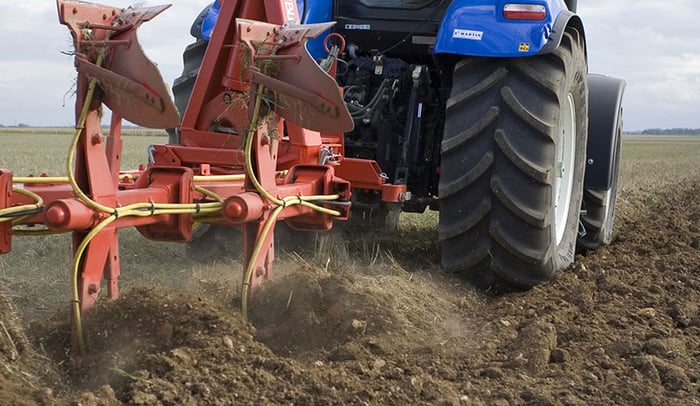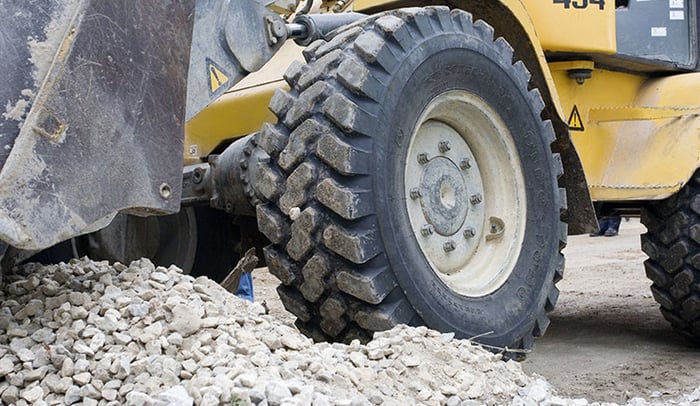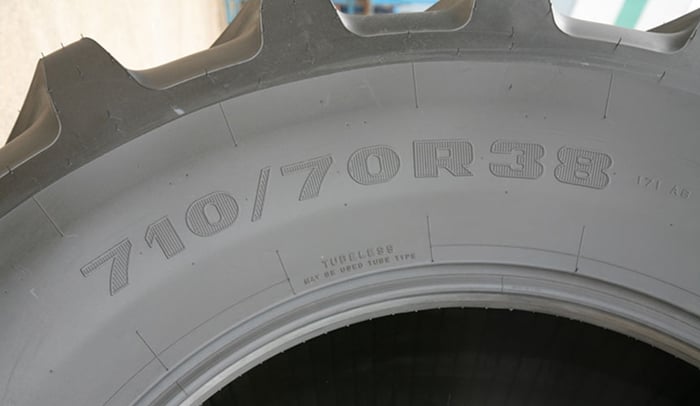Do you know that your tyres, which are your main contact with the ground, can help you make better use or your tractor’s engine power? But for this you must choose the best adapted tyres for your actual use. The tractor manufacturer equipped your tractor with an average tyre which is suitable for nearly all uses, but obviously doesn’t know your needs or your precise use and on top of this, an economic tyre was negotiated with the manufacturer to reduce the global tractor budget.
For these reasons, when it comes to renewing your tyres, you must really consider improving your equipment by choosing a set of tyres that will help you save time, preserve your soil, improve your traction capacity…
Since no two farms are the same, it’s normal for you to choose the tyres that are best adapted to your actual use; you wouldn’t dream of putting on dress shoes to go hiking in the mountains, and the same principle applies to your tyres.
Here is the advice to follow so that your new tyres will allow you to make the most of your engine power:
1. Define your tractor’s principal activity
This is the first thing to take into account: what use will be made of this new set of tyres.
What is your main activity?
- Are they for use exclusively in the fields
- a combination of activities (fields, road, courtyard)
- only for use in the courtyard
- with long trips on the road
- heavy labour including handling on hard ground
Choosing the tyres best adapted to your actual use will bring you better efficiency and productivity and extend their lifespan.
Choosing tyres principally for working in the fields
If you work mainly in the fields, it is highly recommended to opt for very supple tyres to optimise traction capacity while preserving your soil.
Among the different models available on the market, IF tyres meet these requirements perfectly. They have an ingenious design with reinforced sidewalls and can work at very low inflation pressure.
This means that the soil footprint is larger and that your tractor’s pulling capacity is maximised.
 Firestone Maxi traction IF for use in the fields
Firestone Maxi traction IF for use in the fields
Below are the benefits of IF tyres:
- Greater load capacity than a normal tyre of the same size: around 20% more load.
- Soil preservation: working at a pressure as low as 0.6 bar. Attention, inflation pressure must stay within the limit of the load transferred to the tractor’s axle.
- Time saving: no need to adjust pressure between field and road any more.
- Fuel saving: up to 0.7 litres per hectare, time saving, less wear to tyres and mechanical parts thanks to better traction.
Choosing tyres for multipurpose use
In addition to work in the fields, you also use your tractor in the farm courtyard to manage livestock farming activities or carry out other different tasks, inside and around the buildings.
You regularly take the road, and it can be agreed that you use your tractor for a wide range of purposes.
In this case, you should choose tyres designed for multipurpose use which are suitable for use in the courtyard as well as in the fields.
The Performer EXTRA range has been developed using a new generation rubber compound which gives the tyre 20% more resistance to wear. It is equipped with Dual Angle lugs which increase traction capacity in the fields compared to a standard tyre, as well as reinforced casing to resist impacts in the farm courtyard.
This type of tyre is well suited to multipurpose use without fear or wearing too quickly.
Choosing tyres for intensive use
When you work rarely in the fields, but on a range of different hard surfaces, in the farmyard for loading, numerous manoeuvres or for any type of hard labour, the best solution is to choose Utility tyres.
They have a specific tread with robust casing and very thick sidewalls which are designed to resist punctures. Their multi-layer textile structure is highly durable and resistant.
In addition to these interesting characteristics, Duraforce Utility tyres have lugs made of enriched rubber which provide extreme stability for the most delicate manoeuvres. Thanks to the arch in its tread and its thick sidewalls which are highly resistant to impacts and cuts, these tyres provide maximum lateral stability.
You can use them to carry out heavy work on land that is hard, difficult to access, with sharp stones, branches or silex…
 Firestone Duraforce Utility tyre for intensive use
Firestone Duraforce Utility tyre for intensive use
2. Better understanding of your tyre markings
The markings and numbers on the tyre sidewalls contain precious information when buying a new set of tyres.
You have understood that the original tyres correspond to an average solution for everyone. When you change them, this is an opportunity to obtain more from your tractor by increasing your tyre size to be able to carry more load or to reduce inflation pressure.
Understanding the markings on your old tyres is the first step in choosing a better model.
The old markings on agricultural tyres
Written only in inches, the old agricultural tyre markings are composed of a series of numbers with a letter or hyphen in the middle:
- 12.4 - 28
- 12.4 X 28
- 16.9 D 30 or 14 D 30
- 16.9 R 30
- “12.4” “14” and “16.9”: the first numbers indicate the width of the tyre in inches (1 inch = 25.4 mm).
- “-” ”X” and “D” diagonal structure.
- “R”: radial structure.
- “30” and “28”: the last numbers indicate the diameter of the rim in inches.
The new ETRTO markings
The new European ETRTO markings are easier to read and comprise a series of numbers, a slash and some letters:
- 710/70 R38
- 600/65 R26
- 460/85 R38
- “700” “600” and “460”: the first numbers indicate the width of the tyre in millimetres.
- “70” “65” and “85”: the numbers after the slash represents the height of the sidewall as a percentage of the width (aspect ratio or profile). 65% of 600 mm = 390 mm. The higher the number, the higher the sidewall.
- “R”: radial structure.
- “38” “26” and “38”: the last numbers correspond to the width of the rim in inches.

3. Knowing the different types of tyre: radial, diagonal (bias), normal or IF
Agricultural tyres can be broken down into different categories which you need to be familiar with in order to choose the model that is best suited to your use.
Radial tyres
Radial tyres are the most common. They have supple sidewalls mounted on a flexible structure arranged radially and a reinforced tread.
Thanks to these characteristics, the tread and the sidewalls of the tyre can work independently. They are well adapted to work in the fields due to their suppleness and to driving on the road because they are less likely to overheat than other types of tyre.
To get the most from radial agricultural tyres in terms of performance, you need to adapt inflation pressure taking into account several parameters:
- Speed
- Load per axle
- The type of work to be done
Diagonal or bias-ply tyres
The diagonal structure was the norm before the invention of radial tyres. On diagonal or bias-ply agricultural tyres, overlapping layers of chords are laid diagonally across the tyre forming a thick structure. The sidewalls and the top of these tyres are interdependent.
Unlike radial tyres whose soil footprint can be very shallow due to its capacity to spread out, diagonal structure tyres have more of an in-depth impact and are therefore much less suitable for work in the fields. On the other hand, they are adapted to work on harder surfaces because their sidewalls are thicker.
IF tyres
IF technology (Improved Flexion) tyres are among the best on the market.
They are radial structure tyres which, thanks to their more supple yet reinforced sidewalls, can bear up to 20% more load than standard agricultural tyres taking into account the same use criteria as for the previous tyres:
- Speed
- Load per axle
- The type of work to be done
With IF tyres, you no longer need to adapt inflation pressure each time you drive on different ground, in particular during trips from field to road and vice versa.
4. Knowing how to make the most of promotional offers and manage your investments
Good financial management
Did you know that it’s sometimes smarter to take out a loan to cover the cost of good quality tyres?
The current extremely low lending rates are an invitation to change your investment strategy and take a more industrial approach to farming.
Contrary to common belief, the very low or zero interest rate offers, with repayments spread over a long period, should be seen as an opportunity to optimise your profitability.
Without requiring any immediate cash disbursement, you can keep your investment capacity for a more powerful tractor or larger implements, and you can become more productive immediately by spreading the expense over several years, leaving the banks to bear the weight of your investment.
This alternative means that you can give up the idea of second-hand tyres for which you do not know the past history of incidents or wear which could reserve unpleasant surprises at the wrong moment.
Snap up one of the tyre manufacturers’ best seasonal offers
Tyre manufacturers regularly propose interesting promotional offers to boost their sales and your bargaining power is always greater at the end of the year than at the beginning of the year because they have annual sales objectives to meet.
These promotional offers are often more interesting for top quality models and the renewal of your tyres provides an opportunity to move up the range and increase your productivity.
IF tyres will allow you to improve your tractor’s traction capacity considerably by working at low pressure, with a much larger contact patch with the ground:
- The improved traction will reduce fuel consumption representing significant savings at the end of each season.
- The soil preservation will safeguard your productivity and yields for future years, without needing costly deep tilling work for soil decompaction after a few years.
There are numerous possibilities for improving your agricultural machinery and making it more efficient. The tyres are one of these possibilities, particularly if you choose to invest in new tyres by taking advantage of the promotional offers proposed by the tyre manufacturers and the low interest rate financing offered by certain banks.
To help you clearly define the causes of premature wear on your current tyres, we have developed a complete guide for you to download free of charge "How to detect abnormal wear in my tractor tyres"

Most people who read this article have also read some of the following articles:
This information is intended only to make you aware of the technical and functional aspects of agricultural tires and their use. It does not allow you to make a judgment or a definitive conclusion on a given problem. Only your agricultural tire expert is able to make a technical assessment and take a final decision, case by case.